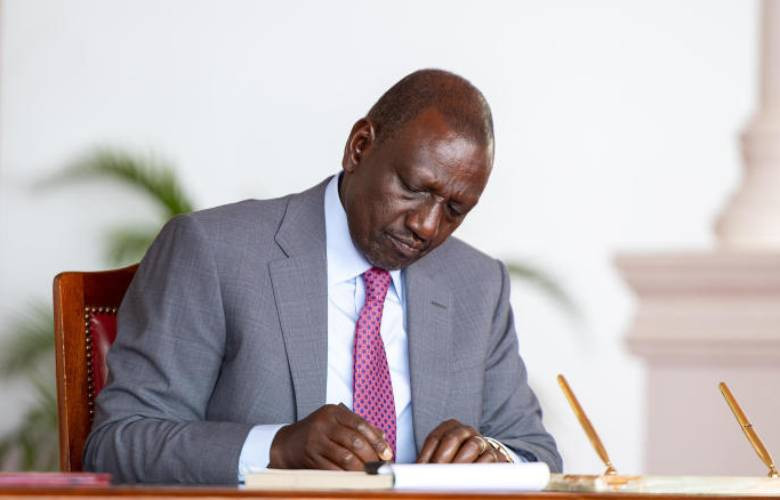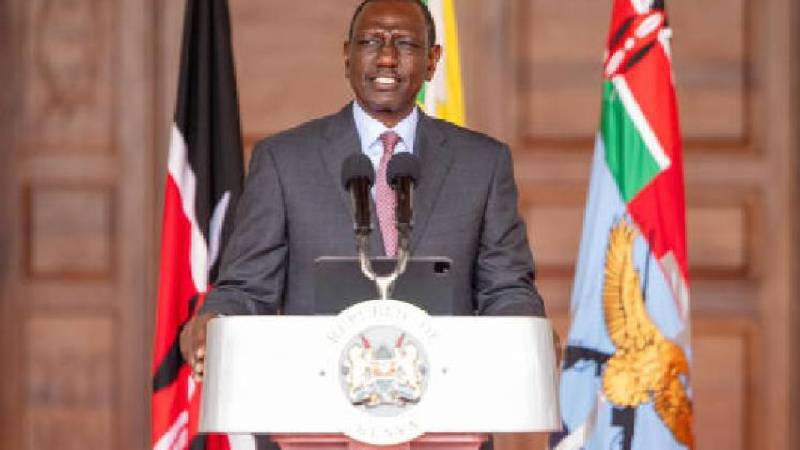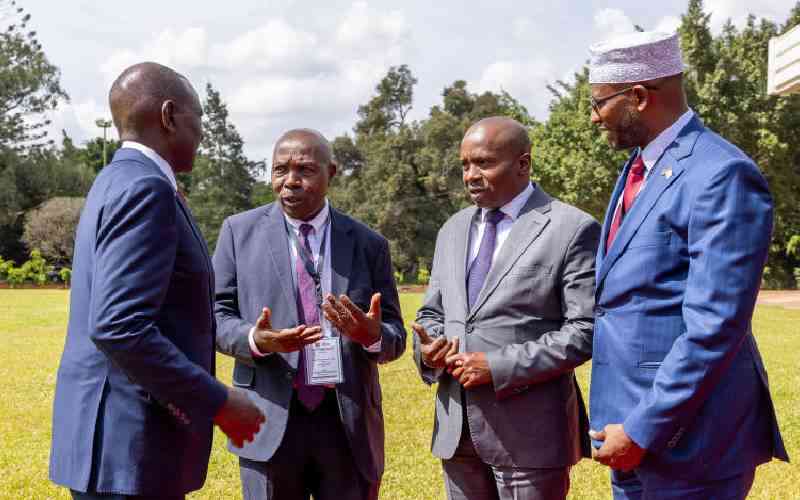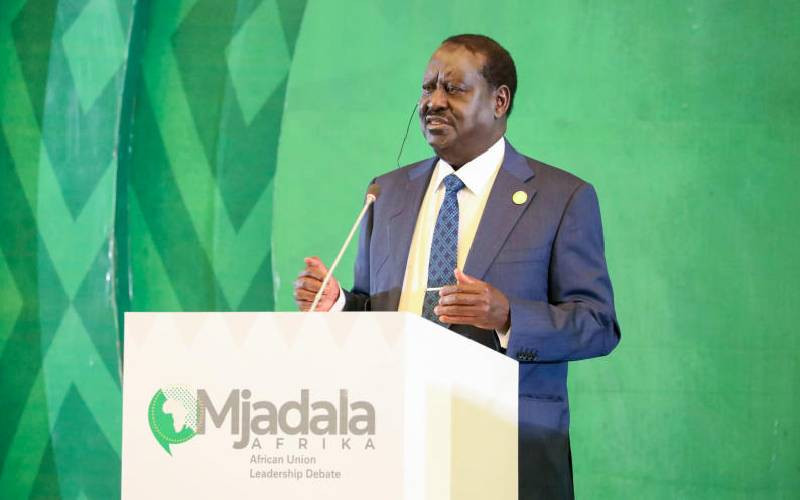 |
|
The government will require foreign mining companies to cede 35 per cent ownership to local investors. |
By WINSLEY MASESE and EMMANUEL WERE
As Kenya finally kicked off its largest mining project this month, there was a mixed sense of hope and uncertainty about the newfound mineral wealth.
Australian miner Base Resources launched its $305 million (Sh25 billion) titanium project in Kwale County.
The first significant export of titanium is expected to be shipped out by early next year.
The amount of titanium in Kwale, if fully explored, is expected to contribute about 10 per cent of the global supply.
It marks a significant milestone for Kenya, a nation whose exports have largely been based on products which sprout above the earth’s surface like tea, coffee and flowers.
The titanium find spurred on other investors and miners to search for minerals across the country.
And it seems that other miners — and the country — have hit the jackpot, with Cortec earlier in the year announcing a $100 billion (Sh8.4 trillion) find of rare earth minerals in Mrima Hills, Kwale.
The rare earths are a very important element in today’s modern manufacturing, especially in the making of mobile phones and laptops — they are important in the making of rechargeable batteries, for example.
But Kenya’s glossy image as the newest mineral wealth frontier might lose its shine as the government maintains high royalty fees and a debate opens up on how best to spread the wealth to the ordinary Kenyan.
The questions
The questions for many Kenyans is how this newfound wealth will translate into a better life for them, and how they can participate in the sector.
With tea, coffee and other horticultural crops, small-scale farmers can easily be part of the boom. They sell their commodities to agencies or middlemen and participate in global trade.
However, in mining, where millions of dollars are required, the onus seems to be on the government to ensure the wealth is shared.
And the possibility of mining companies offloading a 35 per cent stake at the stock exchange might not be as easy as it appears because many Kenyans do not understand the economics of mining.
Stay informed. Subscribe to our newsletter
To protect its share of the cake, the government has taken a hardline stance on royalty fees, charging up to four times the global average in figures revised in August 2013.
Royalties are calculated as a percentage of the value of the minerals being exported.
It is a position that the government is unwilling to climb down from, given the remarks from Mining Cabinet Secretary Najib Balala at the mining and investments conference last week.
For the government, the huge hike in royalty fees seems a way of cashing in on the newfound wealth, especially now that the interest is quite high.
Losing out
“The royalties were last revised in 1999 … they have not been touched since then and now we realise that we have been losing out,” Balala said, insisting that the new royalties would be non-negotiable.
The royalties that went up include those for diamonds, which went to 12 per cent, making it double the global average of 6 per cent.
Niobium, titanium and other mineral sands went up to 10 per cent against a global average of 3.6 per cent.
The wide disparity between Kenya’s royalty fees and the global average for titanium and other mineral sands could be explained away in two ways.
First, in the next couple of years, this group of minerals are the ones likely to be extracted much more than any others because the discovery and the process of extraction has already begun.
Second, the demand for these minerals and rare earths is set to pick up, especially as demand for consumer electronics — phones, laptops and tablets — grows at an exponential rate.
However, players in the mining industry say that a good balance has to be struck when calculating royalty fees.
“There has been an outcry from the industry about the government’s proposal because the royalties put Kenya out of sync with global rates. Remember, investors look for attractive investment opportunities,” said Monica Gichuhi, CEO of the Kenya Chamber of Mines.
Gichuhi adds that the reason some countries have low royalty fees is because they do not have infrastructure. They, therefore, attract mining firms who end up constructing infrastructure, like extending power lines, building railway lines and constructing roads.
“Where there is no infrastructure, royalty fees are low so it balances out the equation. Where the royalty is high, the corporate tax is low,” she said.
Infrastructure
Most developed countries that have been mining for years, like Australia and Canada, have some of the best infrastructure and have lower royalty rates than Kenya’s proposed ones.
On the other tip of the scale are countries like the Democratic Republic of Congo, where the infrastructure is low as are royalty rates to attract investors, who would build roads, rail and power lines.
This infrastructure contributes to the economy many times over after the life of the mine.
DRC charges the lowest royalty fee on iron ore at 0.5 per cent, according to a PWC 2012 survey on royalty charges. Iron ore is a key ingredient in the manufacture of steel, one of the most widely used metals in the world.
For most miners, there is a need to balance government regulations, such as royalty fees, and the fact that the mining industry does not rank tops in terms of returns.
“The average return from mining globally stands at 9 per cent, hardly a high return for businesses,” says Joe Schwarz, Base Resources Ltd’s external affairs manager.
Schwarz says that mining in Kenya is a new thing and many people do not have an idea of what it takes.
It has taken Base Resources over eight-years to finally extract titanium, which can then be exported to other countries for value addition.
“One mine can be very successful with high returns, which might save the investor from other failed exploration and mining projects,” Schwarz noted.
“Out of 20 exploration projects, only one will turn into a mine, so there is a high ratio of failure to success.”
The high-risk nature of mining is what begs the question: are Kenyans willing to pursue this venture.
“Mining is a very competitive business from a global perspective, and there isn’t sufficient understanding and appetite from the Kenyan investor to take the risk and invest in it,” said Schwarz.
The irony, though, is that mining licences are mostly held by speculative Kenyans eager to sell them for a handsome profit to foreign investors as most of them do not have the capital and the risk appetite to be involved in the industry.
Speculative holdings
“Kenyans hold these (mining) licenses the same way they speculate on land, hoping that one day a foreigner will come along or get into a joint venture with them,” said Gichuhi.
“Not many Kenyans are willing to sink money into a hole when you are not sure whether what you are going to look for is actually there. It is like gambling to some extent.”
With the economics of mining not well known to Kenyans, the question is if forcing mining companies to sell more than a third of their stake in the local market makes sense.
Mining, unlike any other business, is a high-risk, capital intensive and long-term project. In numerous instances, explorations are done without knowing the possibility of finding a viable mineral.
In the developed world, mining companies raise cash from their investors by listing on the stock exchange.
Most of these investors are willing to take a very high risk in betting that the firms will strike the jackpot. But they are aware things can also go horribly wrong.
Take the case of Pacific Wildcat, which has a 70 per cent interest in Cortec Kenya.
The company, which is listed on the Toronto Venture Exchange, describes itself as “an African-focused strategic minerals exploration and development company with projects located in East Africa”.
There is a rider to its shares because Pacific Wildcat warns investors that trading in its shares “should be considered highly speculative”.
The firm has not reported any revenues since 2009, and it has not made any profit in its last three financial years.
In April 2013, its shares touched a one-year high of $0.12 (Sh10.2). This seemed a precursor to good news, which came in July when Cortec announced it had discovered rare earth deposits in Kwale worth an estimated $100 billion.
When the announcement was made, Pacific Wildcat’s shares recovered from a dip to hit $0.09 (Sh7.65), the highest the shares had traded at since April.
At that price, an investor at the Nairobi Securities Exchange could have bought shares in Safaricom, Kenya’s largest listed company by revenue and market capitalisation. Safaricom’s shares were at Sh7.05 in July.
But ever since Balala revoked Cortec’s mining licence in early August, Pacific’s shares on the Toronto exchange have been on a downward spiral.
About 40 other mining licences were cancelled, which caused jitters among investors who questioned how the process was done.
According to the Kenya Chamber of Mines, a number of investors held back from putting their money in the sector until the issue is resolved.
Pacific’s shares last week closed at $0.035 (Sh3), a 60 per cent drop since July.
The wide fluctuation in the share price of most of these mining companies, especially the ones venturing into Africa, is the nature of their trading.
If a minerals and metals exchange is set up at the NSE as Balala has proposed, how well will Kenyans understand the trading of these shares to make money?
Or will it be another question of Kenyans burning their fingers and foreigners raking in profits.
Already, with the stock market bullish this year, foreign investors seem to be the ones smiling all the way to the bank as they aggressively trade banking stocks, with the exit of local retail investors.
How best then can you protect the Kenyan investor from themselves?
One school of thought is to have the 35 per cent interest in mining firms held by a vehicle, such as the NSSF or another entity, to hold the shares on behalf of Kenyans.
Unit trusts focused on the mining sector are another way to go about it. These collective investment vehicles have been gaining traction in the capital markets as an avenue retail investors can use for shares and fixed income securities.
The opening up of this market would mean news of a certain discovery of minerals would mean a lot more for Kenyans.
“If you open it up to Kenyans, then the declaration of a mineral discovery would get people excited,” said Gichuhi.
“For example, if Kenyans hear about the discovery of 2,000 tonnes of gold, it would mean something to them.”
Lack of data
Still, there are other challenges facing the industry.
For instance, a lack of data in the country has increased the risks and costs of exploration. It has also driven up speculation as people buy and hold licences.
“The biggest challenge in the sector is lack of information on mineral deposits through geodata,” said Kenya Chamber of Mines Chairman Adiel Gitari.
If geodata is provided, Gitari said it would reduce the risks involved by about 30 per cent.
Kenya uses geodata acquired in the 1960s.
“Availability of data makes the target more visible to aim at. However, it is not a simple exercise to acquire as it requires many years to carry out, as well as a lot of funding,” said Schwarz.
Balala, during last week’s mining conference, promised that the country would carry out an airborne survey to establish what minerals the country has.
Data would also be used to attract investors; its absence tends to scare them away.
Banks, for instance, are said not to extend loans for mining operations due to the lack of data that would inform them on the potential for default.
It is projected that the airborne survey would start from high concentration areas such as the Coastal region — where it is expected to take over two-years to complete — before it moves to low concentration areas.
Other countries with a long history of mining have extensive and up-to-date geodata that guides exploration, thus reducing the risks involved.
[email protected]
 The Standard Group Plc is a
multi-media organization with investments in media platforms spanning newspaper
print operations, television, radio broadcasting, digital and online services. The
Standard Group is recognized as a leading multi-media house in Kenya with a key
influence in matters of national and international interest.
The Standard Group Plc is a
multi-media organization with investments in media platforms spanning newspaper
print operations, television, radio broadcasting, digital and online services. The
Standard Group is recognized as a leading multi-media house in Kenya with a key
influence in matters of national and international interest.
 The Standard Group Plc is a
multi-media organization with investments in media platforms spanning newspaper
print operations, television, radio broadcasting, digital and online services. The
Standard Group is recognized as a leading multi-media house in Kenya with a key
influence in matters of national and international interest.
The Standard Group Plc is a
multi-media organization with investments in media platforms spanning newspaper
print operations, television, radio broadcasting, digital and online services. The
Standard Group is recognized as a leading multi-media house in Kenya with a key
influence in matters of national and international interest.










